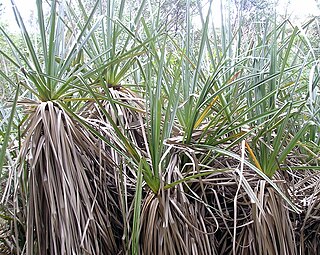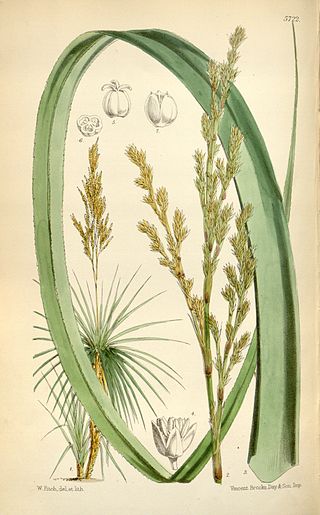
The Poales are a large order of flowering plants in the monocotyledons, and includes families of plants such as the grasses, bromeliads, rushes and sedges. Sixteen plant families are currently recognized by botanists to be part of Poales.

In computational intelligence (CI), an evolutionary algorithm (EA) is a subset of evolutionary computation, a generic population-based metaheuristic optimization algorithm. An EA uses mechanisms inspired by biological evolution, such as reproduction, mutation, recombination, and selection. Candidate solutions to the optimization problem play the role of individuals in a population, and the fitness function determines the quality of the solutions. Evolution of the population then takes place after the repeated application of the above operators.
The Cronquist system is a taxonomic classification system of flowering plants. It was developed by Arthur Cronquist in a series of monographs and texts, including The Evolution and Classification of Flowering Plants and An Integrated System of Classification of Flowering Plants (1981).
Lutz Dieter Schmadel was a German astronomer and a prolific discoverer of asteroids, who worked at the Astronomisches Rechen-Institut (ARI) of the University of Heidelberg.

Heterostyly is a unique form of polymorphism and herkogamy in flowers. In a heterostylous species, two or three morphological types of flowers, termed "morphs", exist in the population. On each individual plant, all flowers share the same morph. The flower morphs differ in the lengths of the pistil and stamens, and these traits are not continuous. The morph phenotype is genetically linked to genes responsible for a unique system of self-incompatibility, termed heteromorphic self-incompatibility, that is, the pollen from a flower on one morph cannot fertilize another flower of the same morph.

Ochnaceae is a family of flowering plants in the order Malpighiales. In the APG III system of classification of flowering plants, Ochnaceae is defined broadly, to include about 550 species, and encompasses what some taxonomists have treated as the separate families Medusagynaceae and Quiinaceae. In a phylogenetic study that was published in 2014, Ochnaceae was recognized in the broad sense, but two works published after APG III have accepted the small families Medusagynaceae and Quiinaceae. These have not been accepted by APG IV (2016).

The Thurniaceae are a family of flowering plants composed of two genera with four species. The botanical name has been recognized by most taxonomists.
The Kubitzki system is a system of plant taxonomy devised by Klaus Kubitzki, and is the product of an ongoing survey of vascular plants, entitled The Families and Genera of Vascular Plants, and extending to 15 volumes in 2018. The survey, in the form of an encyclopedia, is important as a comprehensive, multivolume treatment of the vascular plants, with keys to and descriptions of all families and genera, mostly by specialists in those groups. The Kubitzki system served as the basis for classification in Mabberley's Plant-Book, a dictionary of the vascular plants. Mabberley states, in his Introduction on page xi of the 2008 edition, that the Kubitzki system "has remained the standard to which other literature is compared".

Triuridales was an order of flowering plants that was used in the Cronquist system, in the subclass Alismatidae. It used the folliwing circumscription:
A system of plant taxonomy, the Goldberg system was published in:

Michel Pierre Talagrand is a French mathematician. Docteur ès sciences since 1977, he has been, since 1985, Directeur de Recherches at CNRS and a member of the Functional Analysis Team of the Institut de Mathématique of Paris. Talagrand was elected as correspondent of the Académie des sciences of Paris in March 1997, and then as a full member in November 2004, in the Mathematics section.
The Melchior system, "a reference in all taxonomic courses", is a classification system detailing the taxonomic system of the Angiospermae according to A. Engler's Syllabus der Pflanzenfamilien (1964), also known as "modified or updated" Engler system.

Raúl Rojas González is an emeritus professor of Computer Science and Mathematics at the Free University of Berlin, and a renowned specialist in artificial neural networks. The FU-Fighters, football-playing robots he helped build, were world champions in 2004 and 2005. He is now leading an autonomous car project called Spirit of Berlin.

Picramniaceae is a small, mainly neotropical family of four genera Aenigmanu, Alvaradoa, Nothotalisia and Picramnia. The family is the only member of the order Picramniales. Members of the family were formerly placed in the family Simaroubaceae or misidentified as species in the family Sapindaceae, in the order Sapindales. The most recent standard classification of the Angiosperms distinguishes it as a separate family and order. It belongs to the malvids, one of the three groups that constitute the rosids.

A physical system is a collection of physical objects under study. The collection differs from a set: all the objects must coexist and have some physical relationship. In other words, it is a portion of the physical universe chosen for analysis. Everything outside the system is known as the environment, which is ignored except for its effects on the system.
Energy-shaping control for energy systems considers the plant and its controller as energy-transformation devices. The control strategy is formulated in terms of interconnection in order to achieve a desired behavior.

Prionium serratum, the palmiet, is a robust, evergreen, semiaquatic, rhizomatous flowering plant growing to 2 m in height. It is the only species in the genus Prionium, and is endemic to South Africa. Some authors have separated Prionium from the Thurniaceae, putting it instead in its own family, the Prioniaceae.
Klaus Kubitzki was a German botanist. He was Emeritus professor in the University of Hamburg, at the Herbarium Hamburgense. He is known for his work on the systematics and biogeography of the angiosperms, particularly those of the Neotropics, and also the floristic record of the Tertiary era. His plant systematic work is referred to as the Kubitzki system. He was a member of the American Society of Plant Taxonomists.

Isoquinoline alkaloids are natural products of the group of alkaloids, which are chemically derived from isoquinoline. They form the largest group among the alkaloids.












